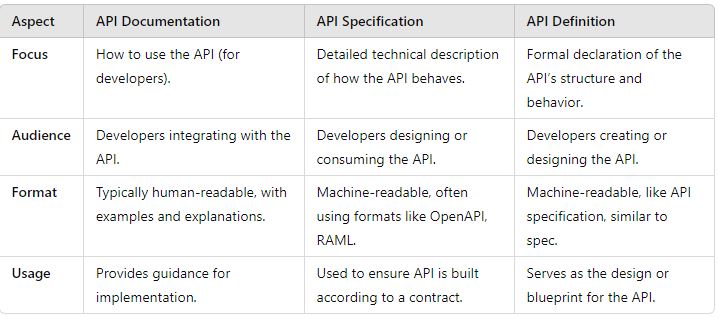API Documentation vs. Specification vs. Definition: What’s the Difference?
While the terms API documentation, API specification, and API definition are very commonly used synonymously, each of these terms actually has a distinct meaning and a different purpose it conveys in API development and usage. Let me illustrate some of their differences below:
API Documentation
Nature: API documentation can be thought of as an elaborative tutorial on how to use an API. This will include exhaustive details about the API endpoint, request parameters, response formats, and error codes, examples-just about everything in the way a client interacts with an API.
Purpose: Essentially, it is used to make developers aware of how and where the particular API has to be used. Usually, this covers some tutorials, code examples, information about authentication, and even some level of troubleshooting.
Content:
- whether they are GET, POST, PUT, DELETE, among others
- Input/Output Formats: XML, JSON;
- Security and Authentication: OAuth, API Keys
- Examples on sending requests
- Response Codes
- Error Handling
Example: Stripe API documentation, which includes how to create payments, retrieve transaction details, and manage subscriptions.
API Specification
API specification is a description of technical and functional aspects of APIs; API specifications are like blueprints, contracts that define what functionality an API should support, along with the way the API would behave. It usually holds input/output schema information on endpoints and sometimes even holds the business principles governing that API.
Purpose: It is designed to specify the structure and behavior of the API being implemented in machine-readable ways. The API descriptions are somewhat an agreement between API producers that are API developers and API consumers- developers using APIs.
Content:
- Data categories and structures
- Endpoint definitions – URLs, methods, expected request / response bodies
- Authentication and authorization mechanisms
- Response status codes
- Validation standards and constraints
- Information about versioning and lifecycle
Example: Open API Specification: formerly swagger, this is the most common specification format, which provides compatibility of the description of APIs on the understandable basis for machines.
API Definition
What it is: The API definition is the formal declaration of the API structure, outlining how the API is built and how it should act. Sometimes used in conjunction with an API specification, it has often been considered a generic term for the “defining” document or process behind the creation of the API’s parameters, structure, and behavior.
API Definition: It is basically the very initiation towards an API development. Hence, it’s more of a technical design document based on which course the development gets started.
Content:
- Methods and endpoints
- Structures for requests and responses, including data type and format
- Security details along with authentication
- Rules for versioning
- Error handling mechanisms
Example: API-restful definition: It describes, through any specification language like OpenAPI or RAML, all available endpoints, how requests are formatted, and what one gets in return.
Key Differences
API Documentation vs. Specification vs. Definition: What’s the Difference?

In summary:
- API Documentation is user-centered, focusing on what a developer should know in understanding the usage of the API.
- API Specification is a technical documentation in nature. It describes an overview of how the API behaves in great detail and mostly is available in machine-readable forms.
- API definition is a more generic term representing the technical design and structure of the API, possibly including the specification and design guidelines.
These functions for API Documentation vs. Specification vs. Definition are quite different, yet complementary.

